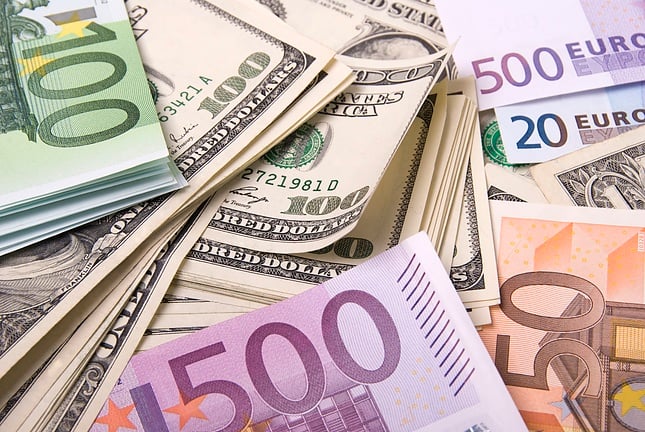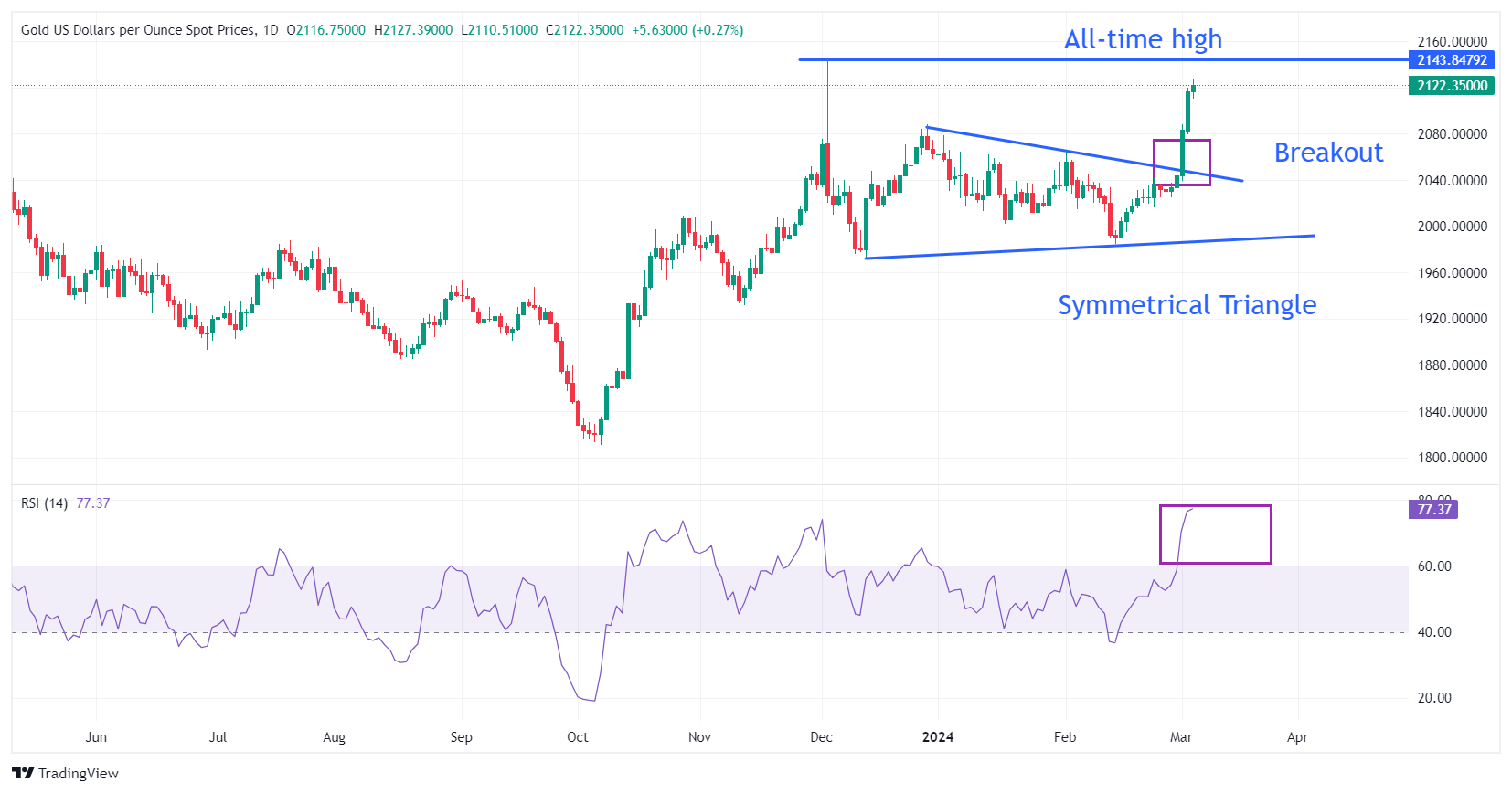- Gold price tests region above $2,140 as investors expect the Fed will cut interest rates in June.
- The US Dollar remains on the back foot ahead of Fed Powell’s testimony, NFP data.
- Fed Powell’s guidance on interest rates will influence market expectations for rate cuts in June.
Gold price (XAU/USD) continues its winning spell for the fifth trading session on Tuesday. The precious metal approaches its all-time high of around $2,145, seen in December 2023 as US Treasury yields come under pressure. The 10-year US Treasury yields drop sharply to 4.15% in the early American session.
Gold’s advance is supported by cautious market sentiment and increased bets that the Federal Reserve (Fed) will cut interest rates in the June policy meeting. However, the near-term outlook for Gold price remains uncertain as investors await Fed Chair Jerome Powell’s testimony before Congress on Wednesday and a slew of labor market data from the United States, such as JOLTS Job Openings for January and ADP Employment Change data, which will be announced on Wednesday.
The commentary from Jerome Powell on the inflation and the interest rate outlook could trim uncertainty associated with the timing of the Fed’s rate cuts. A hawkish guidance on interest rates could weigh on Gold as it will increase the holding cost of investment in non-yielding assets.
Later this week, the US Nonfarm Payrolls (NFP) for February will provide fresh cues on labor demand and wage growth. Apart from keeping inflation under control, reaching maximum employment is a key mandate for Fed policymakers when deciding on interest rates.
Daily digest market movers: Gold price holds onto gains ahead of Fed Powell’s testimony
- Gold price aims to recapture an all-time high near $2,145. The safe-haven demand strengthens as investors seem confident that the Federal Reserve will start reducing interest rates in June. The CME FedWatch tool shows that traders see a little over 52% chance for a rate cut by 25 basis points (bps) in the June meeting. For the upcoming monetary policy meeting on March 19-20, investors see the Fed keeping interest rates unchanged in the range of 5.25%-5.50%.
- The near-term demand for Gold will be influenced by Fed Chair Jerome Powell’s testimony before Congress on Wednesday and an array of United States economic data released later this week.
- Jerome Powell is expected to reiterate that there is no urgency for rate cuts due to resilient economic growth. The Fed isn’t likely to shift from its hawkish stance towards policy normalization until it gets convinced that inflation will sustainably return to the 2% target. The Fed wants to see inflation declining for months as evidence before considering rate cuts.
- On Monday, Atlanta Fed Bank President Raphael Bostic said a strong labor market and decent economic growth have bought time for the Federal Open Market Committee (FOMC) to decide on when rate cuts will be optimal. Bostic added that the Fed is having a “rebounding success” as inflation slowly returns to the desired target without hurting labor demand.
- The US Dollar remains sideways in a narrow range ahead of the US ISM Services PMI for February, which will be published at 15:00 GMT. According to economists, the Services PMI is expected to drop to 53.0 from 53.4 in January.
- The US Manufacturing PMI, released on Friday, was downbeat. A weak Service PMI would raise concerns over economic prospects.
- The US Dollar Index (DXY), which tracks the Greenback’s value against six major currencies, trades near a two-day low around 103.70.
Technical Analysis: Gold price tests region above $2,140
Gold price sees a strong buying interest after it broke out from the Symmetrical Triangle pattern formed on a daily time frame. The breakout of the aforementioned chart pattern exhibits a volatility expansion, which leads to wider ticks on the upside and heavy volume. The precious metal could extend its upside towards the horizontal resistance plotted from the December 4 high at $2,144.48.
The 14-period Relative Strength Index (RSI) holds above 60.00, indicating a bullish momentum ahead. The RSI (14) is not showing any divergence signals but has reached overbought territory.
Fed FAQs
What does the Federal Reserve do, how does it impact the US Dollar?
Monetary policy in the US is shaped by the Federal Reserve (Fed). The Fed has two mandates: to achieve price stability and foster full employment. Its primary tool to achieve these goals is by adjusting interest rates.
When prices are rising too quickly and inflation is above the Fed’s 2% target, it raises interest rates, increasing borrowing costs throughout the economy. This results in a stronger US Dollar (USD) as it makes the US a more attractive place for international investors to park their money.
When inflation falls below 2% or the Unemployment Rate is too high, the Fed may lower interest rates to encourage borrowing, which weighs on the Greenback.
How often does the Fed hold monetary policy meetings?
The Federal Reserve (Fed) holds eight policy meetings a year, where the Federal Open Market Committee (FOMC) assesses economic conditions and makes monetary policy decisions.
The FOMC is attended by twelve Fed officials – the seven members of the Board of Governors, the president of the Federal Reserve Bank of New York, and four of the remaining eleven regional Reserve Bank presidents, who serve one-year terms on a rotating basis.
What is Quantitative Easing (QE) and how does it impact USD?
In extreme situations, the Federal Reserve may resort to a policy named Quantitative Easing (QE). QE is the process by which the Fed substantially increases the flow of credit in a stuck financial system.
It is a non-standard policy measure used during crises or when inflation is extremely low. It was the Fed’s weapon of choice during the Great Financial Crisis in 2008. It involves the Fed printing more Dollars and using them to buy high grade bonds from financial institutions. QE usually weakens the US Dollar.
What is Quantitative Tightening (QT) and how does it impact the US Dollar?
Quantitative tightening (QT) is the reverse process of QE, whereby the Federal Reserve stops buying bonds from financial institutions and does not reinvest the principal from the bonds it holds maturing, to purchase new bonds. It is usually positive for the value of the US Dollar.
Information on these pages contains forward-looking statements that involve risks and uncertainties. Markets and instruments profiled on this page are for informational purposes only and should not in any way come across as a recommendation to buy or sell in these assets. You should do your own thorough research before making any investment decisions. FXStreet does not in any way guarantee that this information is free from mistakes, errors, or material misstatements. It also does not guarantee that this information is of a timely nature. Investing in Open Markets involves a great deal of risk, including the loss of all or a portion of your investment, as well as emotional distress. All risks, losses and costs associated with investing, including total loss of principal, are your responsibility. The views and opinions expressed in this article are those of the authors and do not necessarily reflect the official policy or position of FXStreet nor its advertisers. The author will not be held responsible for information that is found at the end of links posted on this page.
If not otherwise explicitly mentioned in the body of the article, at the time of writing, the author has no position in any stock mentioned in this article and no business relationship with any company mentioned. The author has not received compensation for writing this article, other than from FXStreet.
FXStreet and the author do not provide personalized recommendations. The author makes no representations as to the accuracy, completeness, or suitability of this information. FXStreet and the author will not be liable for any errors, omissions or any losses, injuries or damages arising from this information and its display or use. Errors and omissions excepted.
The author and FXStreet are not registered investment advisors and nothing in this article is intended to be investment advice.
Recommended content
Editors’ Picks

EUR/USD stays weak below 1.0500 due to risk-off mood
EUR/USD remains depressed below 1.0500 in Tuesday's European morning as US President-elect Trump’s tariff plans dampen the market sentiment and keep the US Dollar broadly bid. The Euro struggles due to growing Euro area economic concerns and increased dovish ECB bets.

GBP/USD consolidates losses near 1.2550 ahead of BoE's Pill, Fed Minutes
GBP/USD struggles near 1.2550 in European trading on Tuesday, following a slump to the 1.2500 area. The US Dollar holds on to modest gains amid Trump's tariffs threat-driven cautious mood, keeping the pair undermined ahead of BoE Pill's speech and Fed Minutes.

Gold price defends $2,600 ahead of FOMC minutes; not out of the woods yet
Gold price retains its negative bias for the second straight day and trades just above a one-week low during the first half of the European session on Tuesday. The growing conviction that Donald Trump's expansionary policies will reignite inflation and limit the scope for the Fed to cut interest rates further triggers a fresh leg up in the US Treasury bond yields.

Trump shakes up markets again with “day one” tariff threats against CA, MX, CN
Pres-elect Trump reprised the ability from his first term to change the course of markets with a single post – this time from his Truth Social network; Threatening 25% tariffs "on Day One" against Mexico and Canada, and an additional 10% against China.

Eurozone PMI sounds the alarm about growth once more
The composite PMI dropped from 50 to 48.1, once more stressing growth concerns for the eurozone. Hard data has actually come in better than expected recently – so ahead of the December meeting, the ECB has to figure out whether this is the PMI crying wolf or whether it should take this signal seriously. We think it’s the latter.

Best Forex Brokers with Low Spreads
VERIFIED Low spreads are crucial for reducing trading costs. Explore top Forex brokers offering competitive spreads and high leverage. Compare options for EUR/USD, GBP/USD, USD/JPY, and Gold.
